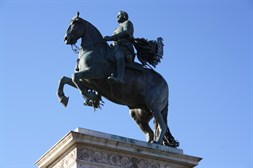The equestrian statues and the Spanish monarchy
 An expression of a recurring theme in Western art since the times of ancient Greece, the equestrian portrait also gained prominence in the Baroque period with the aim of celebrating and immortalizing the life and work of famous people, especially the sovereign. Following the Roman model of the statue of Marcus Aurelius and the Renaissance monument to Gattamelata by Donatello, many artists took up the challenge of a similar task. In the Baroque period, one can cite the examples of the equestrian statue depicting King Louis XIV of France, designed by Gian Lorenzo Bernini, or the famous sculptures with which the Florentine Francesco MochiFrancesco Mochi (1580-1654) can be counted among the initiators of the Baroque in Italy. Trained in Mannerism, the Tuscan sculptor was often at odds with Bernini. Among his works was the group of the Annunciation in the cathedral of Orvieto, the equestrian monuments of Alessandro and Ranuccio Farnese and Saint Veronica in Saint Peter’s Basilica in Rome. in Piacenza depicted the likenesses of Alessandro and Ranuccio Farnese. In this context, a special place must be reserved for the equestrian statues that depicted the sovereigns of Spain in the seventeenth and eighteenth centuries.
An expression of a recurring theme in Western art since the times of ancient Greece, the equestrian portrait also gained prominence in the Baroque period with the aim of celebrating and immortalizing the life and work of famous people, especially the sovereign. Following the Roman model of the statue of Marcus Aurelius and the Renaissance monument to Gattamelata by Donatello, many artists took up the challenge of a similar task. In the Baroque period, one can cite the examples of the equestrian statue depicting King Louis XIV of France, designed by Gian Lorenzo Bernini, or the famous sculptures with which the Florentine Francesco MochiFrancesco Mochi (1580-1654) can be counted among the initiators of the Baroque in Italy. Trained in Mannerism, the Tuscan sculptor was often at odds with Bernini. Among his works was the group of the Annunciation in the cathedral of Orvieto, the equestrian monuments of Alessandro and Ranuccio Farnese and Saint Veronica in Saint Peter’s Basilica in Rome. in Piacenza depicted the likenesses of Alessandro and Ranuccio Farnese. In this context, a special place must be reserved for the equestrian statues that depicted the sovereigns of Spain in the seventeenth and eighteenth centuries.
The crowns of Castile and Aragon, united by the marriage (1469) of the Catholic Monarchs Ferdinand and Isabella, girded the heads of the rulers of the Habsburg dynasty for almost two hundred years. After Philip I known as “the Beautiful”, the husband of the daughter of the Catholic Kings Joanna “the Mad”, Charles V (1500-1558) was the first Habsburg monarch to make of Spain the main power of the time. When he decided to abdicate (1556), his vast possessions were divided between his brother Ferdinand, who received the Empire, and his son Philip II (1527-1598), who succeeded him as the head of a monarchy which included, outside the Iberian peninsula, the kingdoms of Naples, Sicily, Sardinia, the duchy of Milan, the Netherlands and the American colonies. During the seventeenth century he was followed on the throne by Philip III (1578-1621), Philip IV (1605-1665) and Charles II (1661-1700). On the death without heirs of the latter, and after the War of the Spanish Succession, a new dynasty, the Bourbons occupied the throne, whose initiator was Philip V (1683-1746).
